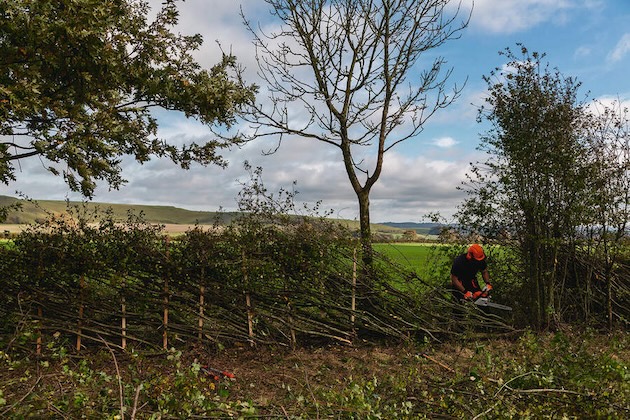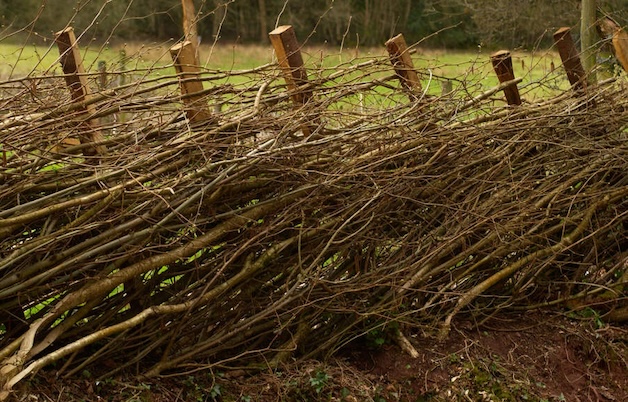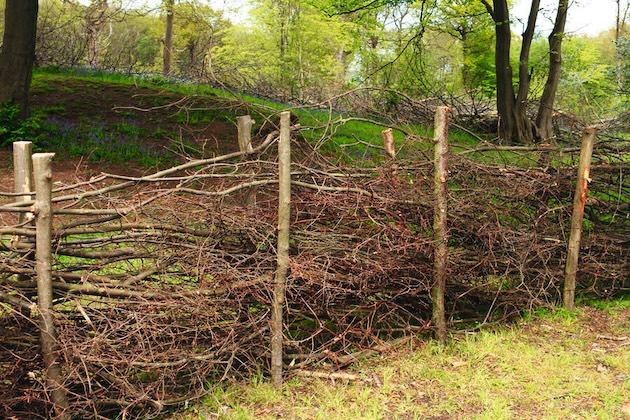Imagine that you have been parachuted into the English countryside from some distant planet. How do you establish exactly where you are? Look at the local hedges
Depicting local hedgelaying patterns is like reading a map. Walk over to a newly cut-and-laid hedge. If it is 4ft 6in high, with hazel stakes and woven hazel binders along the top, then you are in Midlands foxhunting country.
If the stakes are of sawn timber and there are no binders, then you are in Derbyshire.
If the sawn stakes are 18in apart on alternate sides of the hedge and the pleachers are laid at 45 degrees, then your most probable location is in Lancashire or Westmorland.
If the hedge is on top of a bank and the binders are secured with crooked hazel sticks, you are in Devon, while if the hedge is narrow and finished with sawn stakes and rails, you have landed in Yorkshire.
Just as our native livestock breeds were developed to suit local conditions of soil and climate, and vernacular building styles vary from district to district according to landscape and geology, so do the ways in which fields are fenced and hedgerows cut and laid.
“There are about 35 different styles, different families of styles and even styles particular to individual estates,” according to Robin Dale, chairman of the National Hedge-laying Society (NHLS). “The radius that different hedge layers worked in the past would have been no more than five miles. Each would have his own style and someone else would have another way of doing things. Even the designs of axes and billhooks would be different, because the blacksmith was making that billhook for that man. You weren’t going to be influenced by someone on the other side of the country, and that’s how regional differences came into being.”
The development of hedgelaying
Foxhunting was one of the main factors behind the development of hedgelaying. The craft not only created a stockproof fence capable of containing bullocks, which might weigh a ton apiece before being sold in Melton market, but it also produced a challenging though uniformly contoured obstacle for the horseman.

“The binders are on the top of the hedge to keep the hedge down, but they also gave you a precise take-off line. And where we cut the stakes at a 45-degree angle with the ditch on the nearside, if your horse didn’t get high enough, then you slid over and didn’t stake your horse. It’s all about hunting, without a shadow of a doubt,” says Dale.
Sporting estates and hunts kept the skills of hedgelaying going during the last war and up until the mid Seventies, during a time when the richness and diversity of our countryside was under huge pressure from the economics of agricultural change.
Nowadays, however, hedgelaying is undergoing a renaissance, both for wildlife conservation reasons and simply because landowners are once more appreciating the pure aesthetics of a beautifully cut-and-laid hedge. The present guardian of the rich diversity of regional styles is the NHLS and there is nowhere better to appreciate and understand the finer points of that diversity than at the Society’s annual championships.
Undoubtedly, the classic cut-and-laid hedge is the Midland style, which was developed for farms with large animals where the hedges needed to be able to withstand the weight of a heavy beast pushing against them.

The stems are “pleached” or cut half through, turned almost horizontal to the ground and held in place with a row of stakes 18in apart. Finished to a height of 4ft 6in, the hedge is topped off with a continuous line of hazel binders. “When we’ve finished, you’ll see that it is a living stockproof barrier,” commented Nigel Adams, a competitor in the Midland open class and NHLS spokesman. “Before wire fences were invented, this is how we kept animals in and out of fields. All the brush is turned towards the side where the stock are, while in the old days the field on the clean side would go into a crop rotation.”
Wales and sheep
On the Welsh borders, the hedgelaying is designed to contain sheep rather than strong cattle, so the finished hedge is packed with dead wood to prevent the sheep nibbling away at the regenerating shoots. A further feature is that the stakes are set at an angle to ensure that rainwater running down them is kept away from the stools so that they will not rot.
Lancashire and Westmorland style
In complete contrast is the Lancashire and Westmorland style, in which the pleachers are simply pushed over at an angle of 45 degrees between a double row of stakes. “It’s very quick and practical, and the farmers up in Cumbria and on the fells can lay up to 100yd a day,” South of England intermediate judge Dave Sands told me. “It doesn’t have any binding in the top, but the stakes hold it from popping out the sides until the new growth comes through the bottom.”

Regeneration
If it is unmanaged over a long period, a hedge will attempt to grow into a line of trees, with nothing at the bottom to contain livestock or, for that matter, to provide shelter for game and wildlife. Even if it is trimmed mechanically, after a few decades the plants will degenerate and start to die back. The process of hedgelaying, in which the living stems are pleached and pushed down to the ground, initiates a burst of new growth. Fresh shoots emerge from the partially severed stools and drive upwards between the tightly compacted old stems and the cycle of growth starts once more.
The clean, tidy lines of a newly laid hedge may only last for two or three seasons until the new growth gets away, but by then the hedgelayer has fulfilled his objective by maintaining a secure barrier to livestock and protecting the hedge stools from browsing. When it has reached an appropriate height, the new growth can be managed mechanically with a conventional hedge trimmer, the height being raised every few years to allow the top to thicken out. Then after 15 or 20 years, when it has grown to 10ft-12ft, the hedge can be relaid.
Much of the secret of laying a hedge to the exhibition standard required in the national championships is in cleaning it of all extraneous matter and retaining useful cuttings to insert into gaps. John Savings lays hedges in the South of England style. As soon as he gets going on his 10yd competition length, which must be completed within five hours, he is busy with a rake, pulling out dead grass and ripping down briars and brambles.
“I work on cleaning it as I go along, untangling it and keeping every bit of material I possibly can. Clean it out, cut it with the axe and see how it goes, then gap it up,” he says. “When you’re doing contract work, that’s what it’s all about: hedgelaying is about filling them gaps.”
Cost effective?
But can the painstaking and time-consuming task of cutting and laying a hedge by hand really stack up commercially against modern stock fencing? Dave Sands thinks so: “The cost of different styles varies. A hedge laid in the South of England style will cost about £10 to £12 per metre and today, with a chainsaw, a man can do about 30 to 40 metres a day. We supply all the stakes and the binders, and there’s lots of hazel for binding and chestnut for stakes down in Sussex. Apart from that, it’s pretty much purely labour, and a lot of people find that unacceptable these days, I suppose.
“Compare it with wire stock fencing, where you have to buy the wire and the posts and strainers and then pay for the labour on top of that. Wire fencing costs about £5.50 per metre and will last up to 15 years, but a good laid hedge will last 25 years if it’s well maintained and looked after.”
And, of course, it looks so much more attractive, it’s better for wildlife, there’s no barbed wire involved and you have a living structure that merely requires occasional trimming.

There’s even a therapeutic value to hedgelaying. As Savings points out: “Over the years, the country crafts like thatching, hedgelaying and drystone walling have been coming back. They can see that we’re happy, not a worry in the world, so they think. Like the man who taught me [who believed] when you’ve got problems, all you have to do is take your tools, walk over two fields, do a bit of hedgelaying and it all blows away.”
Perhaps it’s not surprising that landowners are looking again at hedgelaying, especially where the hedges concerned are an important visual feature in the landscape or are valuable from a sporting perspective. Newly planted hedges will generally become suitable for laying after around 12 to 15 years of growth, depending, of course, on the soil they are growing in. If planting a hedge with traditional cutting and laying in mind, some species might be more appropriate than others.

“The best advice when planting hedges is to look around one’s own area,” says Adams. “That way, you can see what grows best in that soil. Most of the Midlands were planted with only hawthorn during the enclosures, but if you want to offer wildlife a few other species, then hazel and blackthorn are the most popular. As a rule of thumb 60% to 70% should be just hawthorn or hazel with a mix of other species added according to conditions.”
Blackthorn is good for wildlife but can spread out of the hedge if not managed. Maple provides nice autumn colour but really wants to be a tree and can dominate, while some hedgelayers don’t like dogwood because it is liable to snap rather than bend. It does provide attractive colour in autumn, though.
You should aim to plant five whips per metre in double, staggered rows 45cm apart. Remember that hedgerow trees are also an important part of a hedge, and a tree planted roughly every 30 metres will go some way to augmenting a declining stock of hedgerow trees in Britain.
If you want a new hedge to get away quickly then I can add a further tip. Having planted your new whips, cut them off with a pair of secateurs at an angle just 4in above ground level, roll black plastic sheeting over the hedge line so that the sharp points push through, then enclose the hedge in a double rabbit fence. The plastic will suppress weed growth and warm the soil quickly in spring. It will also ensure that each plant sends up a series of new leaders thereby creating a thick, bushy bottom. I have a kilometre of hedge which I planted in this way in 2004. It is now 8ft to 10ft high and will be ready for laying within five or six years, although I haven’t as yet decided in which regional style.
This article was originally published in 2012 and has been updated.






